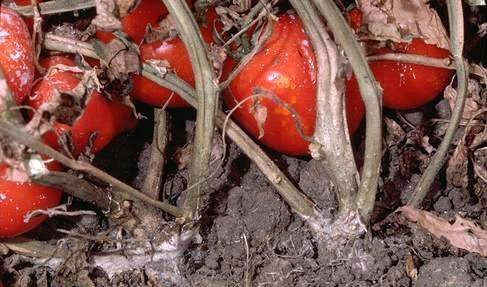Southern Blight of Tomato
 Causal Agent
Causal Agent
The fungus, Sclerotium rolfsii
Hosts
Tomato
Symptoms
The initial symptoms of southern blight is a rapid wilting of the entire plant. A water-soaked lesion on the stem near the soil line rapidly expands, turns brown, and girdles the stem. A white mold (mycelium) eventually covers the stem lesion and surrounding moist soil. Small, uniformly round structures about 1/16 inch in diameter, called sclerotia, form on the mycelium. Sclerotia are first white, later becoming brown, and resemble mustard seeds. The presence of the white mycelium and sclerotia at stem base of afected plants are very useful characteristics for identifying southern blight. The fungus survives in the soil as sclerotia which may build to high numbers when susceptible plants are cropped repeatedly. After sclerotia germinate, the fungus must first colonize organic debris near the soil surface before the fungus can cause infection. The disease is favored by high humidity and soil moisture and warm to hot temperatures (85-95 F).
Control
Southern blight is difficult to control when conditions favor the disease and when numbers of sclerotia in the soil are high. Crop rotation with a non-susceptible grass crop such as corn is the most effective means of reducing numbers of sclerotia and resulting indicidence of southern blight. Avoid planting tomato following a very susceptible crop such as peanut. Plant residues should be thoroughly incorporated into the soil prior to transplanting so that their presence on the soil surface does not encourage southern blight development. Side-dressing with ammonium nitrate rather than other forms of nitrogen and use of a soil fungicide at transplanting may provide some control. Please contact your local county extension office for current information.
